
THE HVAC SYSTEM
The main goal of any HVAC system is to provide comfort. The American Society of Heating, Refrigerating and Air-Conditioning Engineers (ASHRAE) has established room conditions that are acceptable for most building occupants. Comfort in a space depends on a combination oftemperatureandhumidity. Figure 1 shows the comfort zones for summer and winter as defined in ASHRAE Standard 55. The comfort zone is the range of conditions that satisfy most people who are appropriately dressed and are doing light work, such as office work. People doing heavy work and those wearing heavier clothing may need cooler conditions. The summer and winter comfort zones are slightly different because people dress differently for each season.Ventilation (outside air) must be provided to every occupied building. Supplying a certain amount of outside air prevents the indoor air from becoming stale and unhealthful. Building codes specify the amount of ventilation air that must be introduced by the HVAC system.
An HVAC system conditions the supply air to provide the spaces with an acceptable combination of humidity and temperature within the comfort zone. It also provides a sufficient amount of outside air for ventilation. The effectiveness of the system depends upon two factors:
To heat or cool a space, these two factors are combined in different ways depending upon the type and design of the particular HVAC system. The combinations are:
As the indoor air temperature varies, the humidity also increases or decreases. The indoor humidity generally remains within the comfort zone. However in dry climates, many HVAC systems have a humidifier unit in the central air handler to increase the moisture level in the conditioned air when it is needed. In humid climates, systems may have a means of removing moisture from the supply air.
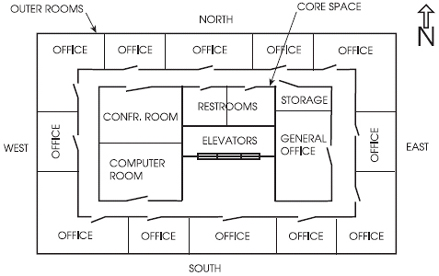
DIFFERING ZONES
In large buildings, the HVAC system must meet the varying needs of different spaces. Different zones of a building have different heating and cooling needs.In the past, large commercial buildings were usually designed with a central light well. This admitted light and air to the inner rooms. As building and land costs increased and HVAC systems developed, this inner light well was eliminated. Now buildings are designed with a core of inner rooms where the light well used to be (Figure 2). The development of this inner core created a new air conditioning problem. The core spaces do not require heating, but do require cooling and ventilation.
The rooms along the outer walls require either heating or cooling as well as ventilation. These outer rooms are also called perimeter spaces.
Consider the needs of different zones in a typical office building which have different heat loss and heat gain characteristics. The offices are arranged around the outer walls of the building, with an inner core of rooms that have no outside exposure (Figure 2).
The outer rooms have at least one wall exposed to the outside temperatures. This means that these offices have more heat loss and heat gain than the interior rooms:
The outer rooms gain or lose heat at a varying rate. For example, when the sun strikes one side of a building, that side has more heat gain than the sides that are shaded. The position of the sun, color of the wall, insulation, amount of glass, and shading all affect this solar heat gain.
The core of the building gains heat from the interior load such as people, lights, and equipment. Therefore, these spaces generally do not require heating except for a top floor where heat is lost through the roof. The normal condition is that they gain too much heat and therefore require cooling when occupied.
The cooling load for both core spaces and outer spaces depends on many factors such as these:
Since different spaces have different rates of heat gain and heat loss, it is impossible for an HVAC system that delivers the same temperature of air at a fixed volume to every space
to provide comfort conditions for all of them. Therefore, heating and cooling must be supplied at varying rates to different zones of the building. A zone is a space or group of spaces in a building with similar requirements for heating and cooling. All rooms in a zone can be supplied with the same temperature supply air at the same flow rate.

SINGLE ZONE SYSTEM
The first HVAC systems were single zone systems (Figure 3). These systems treat the building as a single zone. They deliver air from a central air handling unit at a constant volume and a varying temperature (CV-VT). The central air handling unit in any HVAC system is the equipment in the mechanical room or on the roof that conditions the primary supply air and delivers it to the spaces.The single zone system is still used in residences and in small commercial buildings. The single zone system is effective in a small building because the heat gain and heat loss for different areas may not vary a great deal.

MULTIZONE SYSTEM
The multizone system (Figure 4) was an early system that was designed to meet the varying needs of different zones. It has a separate supply air duct to each zone in a building. There is a heating coil and a cooling coil in the central air handling unit. Both coils are in operation at the same time. Dampers after the coils mix the hot and the cold supply air to the temperature needed to satisfy each zone.When heating and cooling occur at the same time it is called bucking because the heating and cooling coils are working against each other. The supply air to each zone is mixed to a temperature somewhere in between the hot and the cold supply air. The multizone system uses too much energy to heat and cool the air at the same time.
Because they waste energy, multizone systems are no longer being installed. They are generally banned by local building codes throughout the country.
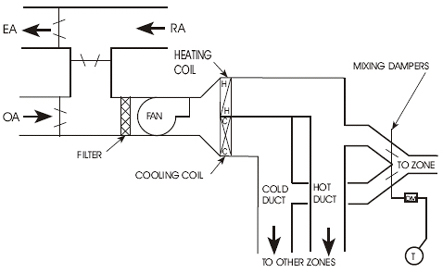
DUAL DUCT SYSTEM
The dual duct low pressure system (Figure 5) was also designed to meet the comfort needs of different zones. A dual duct system has two separate supply ducts from the HVAC unit to the outlets in the spaces. One duct supplies cold air, and the other supplies heated air. In this system both the heating and cooling coils operate at the same time, just as with the multizone system. The hot air and the cold air are mixed with dampers at each zone in order to obtain the air temperature needed for that zone. This system is intended to be constant volume-variable temperature (CV-VT).This system also uses too much energy because the hot air and cold air are bucking each other. Therefore the dual duct system that mixes hot and cold air is now generally banned.
The dual duct system also has other problems. The cold duct usually requires most of the supply air. This results in less flow in the hot duct at times and therefore a higher hot duct static pressure. When a zone called for heating, the high static pressure in the hot duct resulted in a high cfm that created drafts and noise in the conditioned spaces.
HIGH PRESSURE MIXING BOXES
To solve the problems of non-constant airflow rate in a dual duct system, a high pressure mixing box was developed. This replaced the mixing dampers. The mixing boxes control the cfm to a constant flow rate. The boxes change the system into a true constant volume-variable temperature (CV-VT).
The dual duct mixing boxes require a high static pressure to operate - usually a minimum of 1.5 inches wg. The system itself generally requires about 3.0 inches wg duct pressure to operate properly. The high fan horsepower required to maintain the high static pressure, plus the bucking condition, means a high energy usage. The cost of operating the dual duct system was too high.
Another problem was that, because of the higher pressure often present in the hot duct, the hot air might flow back through the mixing box and into the cold duct. This could raise the air temperature in the cold duct so that the supply air could not cool the spaces adequately.
LOW PRESSURE REHEAT BOXES
Later, low pressure reheat units for the zones were developed. The supply air had to be cold enough to meet the needs of the zone with the greatest cooling load. The supply air to all other zones had to be reheated. There was no temperature control unless the boiler was operating. In the summer when the boiler was normally turned off, the system could only deliver cold air that was produced by the central cooling system. Often the conditioned spaces were too cold.
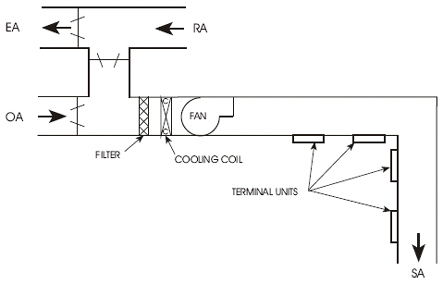
VAV SYSTEMS
Variable air volume (VAV) systems (Figure 6) were developed to be more energy efficient and to meet the varying heating and cooling needs of different building zones. A zone can be a single room or cluster of rooms with the same heat gain and heat loss characteristics.VAV systems can save as much as 30 percent in energy costs as compared to conventional dual duct systems. In addition, they are economical to install and to operate. Duct sizes and central air handling units are smaller and the design and installation is generally much simpler.
The main duct for a typical VAV system provides cooling only (at approximately 55°F). This is called primary air. Room thermostats control the amount of primary air delivered to each zone through modulating dampers for each zone. These dampers vary the volume of air to each zone according to the cooling needs.
Early VAV systems varied the fan cfm output according to the total need of the zones. The fan was sized for the maximum probable load. As the air volume for the zones varied, the static pressure (SP) in the main duct tended to vary. An SP sensor in the main duct controlled the fan output to maintain a constant supply duct static pressure. The fan output was varied either by fan inlet vanes or by a damper at the fan outlet. These systems were variable volume-constant temperature (VV-CT)
Early VAV systems were cooling only, so a separate source of heat was needed for the outer rooms. This was usually supplied by perimeter heating in the rooms.
These early VAV systems were low-cost to install. However, depending upon the position of the zone dampers, the zones were subject to delivering too much cold supply air, which sometimes created drafts and air noise. These systems were very difficult to balance.
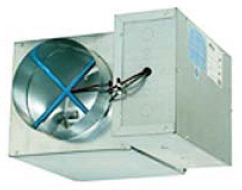
To better control the secondary air delivered to each zone, the VAV terminal unit was developed. A terminal unit is a small metal box (Figure 7) located in the supply air duct just before the outlet of each zone. A terminal unit is also called a VAV box, VAV unit, or outlet box.
Each terminal unit (Figure 8) receives primary air from the central air handling unit at the same temperature (about 55°F). The terminal unit contains a primary-air damper (a butterfly damper) which modulates (changes position) according to signals from the automatic control system. (A modulating damper is not just open or closed. It can be at any position in between.) The primary-air damper regulates the volume of cold primary air delivered to the terminal unit according to the needs of the spaces. This is also the volume of secondary air delivered to that space. Figure 8 shows only the key features of a terminal unit.
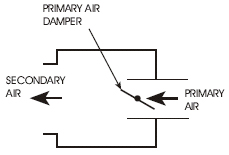
The big advantage of VAV systems with terminal units is that they are able to meet the comfort requirements of different zones in a building without heating and cooling at the same time.
PRESSURE DEPENDENT OR PRESSURE INDEPENDENT
VAV systems are either pressure dependent or pressure independent.
The first VAV terminal units were pressure dependent. They had no means for limiting the quantity of supply air.
In pressure dependent systems, the volume of air supplied by the terminal unit varies depending upon the static pressure (SP) in the primary air duct. The primary-air damper in the terminal unit is controlled by a thermostat in the space. However, the airflow through the damper varies according to the SP in the main duct. Terminal units that are close to the supply fan are likely to supply too much primary air. Terminal units that are farthest from the supply fan are not likely to supply enough primary air.
Pressure independent terminal units have flow-sensing devices that limit the flow rate through the box. They can control the maximum and minimum cfm that can be supplied and are therefore independent of the SP in the primary air duct.
Almost all HVAC systems installed or retrofitted at present have pressure independent VAV terminals. Pressure independent systems can be balanced and will allow the correct airflow from each terminal.
VARYING FAN SPEED
Because each terminal unit regulates its primary air volume independently, the volume (cfm) of primary air delivered by the central air handling unit varies according to the demands of the terminal units in the system. This means that the supply fan in the central air handling unit must vary its output in order to meet the needs of all the terminal units. If the primary-air dampers of most terminal units are full open, the cfm required for the entire system is high. If most terminal unit dampers are closed, the cfm required for the system is much less.
In many current systems, the rpm (speed) of the central supply fan is regulated by the control system to meet the changing demands of the system. A static pressure (SP) sensor in the primary air duct sends a signal to a controller that regulates the fan speed to maintain a constant SP in the primary air duct.
The location of the SP sensor in the primary duct is critical to the performance of the system. It is best placed near the terminal unit that is most difficult to supply. This is the location that has the greatest pressure drop from the fan. If the sensor is placed too close to the supply fan, the SP in the supply duct will be too high during periods of low cfm demand.
IMPROVEMENTS IN VAV SYSTEMS
Early VAV systems were not highly regarded by HVAC technicians. They were considered almost impossible to balance and to keep in balance. Today, pressure independent VAV systems are widely regarded as the best HVAC system design available. This change is largely a result of improvements in the terminal unit.Many VAV systems and terminal units have been developed to provide for the particular needs of a building. The following are the commonly used types:
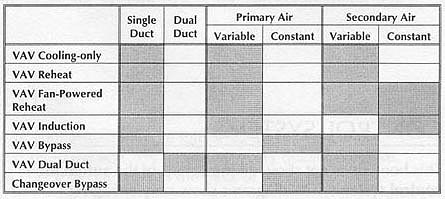
These seven types of VAV systems and their characteristics are summarized in the chart above.
OTHER IMPROVEMENTS
Digital control systems have greatly improved VAV system performance. Digital controls are more accurate, and they can manage more complex functions. In addition, digital controls input information into a central processing unit (CPU). The CPU is a computer that generates reports analyzing system performance. The CPU can also be used to change the parameters of the system by remote control.
Better sensors are used with the control system to measure such factors as temperature, static pressure, and total pressure more accurately and reliably. This allows for faster and more consistent control of the terminal units.
Better fan speed control allows a VAV system to meet varying demands.
Better design of terminal units has simplified and improved them. Design of outlet diffusers has improved to allow more complete penetration of the conditioned air into the space.
Installation and balancing methods have been improved.
CONTROL SYSTEMS
VAV systems are controlled by either digital or pneumatic control systems.At present, most VAV systems are controlled by digital stand-alone control systems. Digital control systems have many advantages:
Excerpted and reprinted from Variable Air Volume Systems by Leo A. Meyer, one of the books in the Indoor Environment Technician's Library series published by LAMA Books. For over 30 years, Meyer has been writing and publishing training materials for the HVAC industry. His books cover a wide range of topics, including heating and cooling, indoor air quality, sheet metal work, electricity basics, safety, and others. For more information, visit www.lamabooks.com.
Publication date: 05/01/2006

Report Abusive Comment